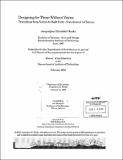| dc.contributor.advisor | Jan Wampler. | en_US |
| dc.contributor.author | Henke, Jacquelynn Elizabeth, 1975- | en_US |
| dc.contributor.other | Massachusetts Institute of Technology. Dept. of Architecture. | en_US |
| dc.date.accessioned | 2011-11-21T18:31:40Z | |
| dc.date.available | 2011-11-21T18:31:40Z | |
| dc.date.copyright | 2000 | en_US |
| dc.date.issued | 2000 | en_US |
| dc.identifier.uri | http://hdl.handle.net/1721.1/67279 | |
| dc.description | Thesis (M.Arch.)--Massachusetts Institute of Technology, Dept. of Architecture, 2000. | en_US |
| dc.description | Includes bibliographical references (p. 114-115). | en_US |
| dc.description.abstract | "In the end, we will conserve only what we love. We will love only what we understand. We will understand only what we are taught." - Baba Dioum - Senegalese conservationist. In the past two decades, zoos have taken on new responsibilities and roles shifting them from places of primarily recreation and entertainment to places where education and conservation are at the forefront. These changes impact all aspects of the zoo, most importantly its design. Visitors journey to the zoo in search of animals. They could find them behind bars, in the center of a deep moat or search for them in an extensive landscape that replicates the animal's wild habitat. The later is clearly the situation that can not only fascinate, but also educate the visitor. There are many existing animal exhibits that use the idea of landscape immersion in their design, but still they fall short of their potentiaL This thesis focuses its efforts on the design of one habitat for a zoo in Boston, Massachusetts. The mammalian residents of the exhibit, from the Congo region in Africa, are not often seen in zoos but their need for help is no less pressing. The thesis pushes the boundaries of the idea of what an exhibit should be and challenges the already traditional aspects of zoo design. It explores the potential that an exhibit can have not only from the point of view of the animals, but also from the visitors. Clear ideas on path and place manifest themselves in the design, which allows visitors to move through the habitat freely, offering the possibility to see its residents from unique views and spaces, all the while learning about important issues surrounding these animals in Africa and issues surrounding the zoo community. The messages are sent overtly to the visitor through distinctive displays and interactive learning stations. In addition, messages can be received subconsciously simply through the different experiences that the visitor is exposed to while moving through the interior and exterior parts that compose the exhibit. The design strives to integrate the landscape with the built form. Through this integration we learn as much as about the union of the parts as we do about the individual pieces. The two areas are less about the separation of inside to outside or nature to building as they are about environments to live and learn in. They are inseparable and need each other to function, a point often missed in current exhibits. Results of this thesis show the great possibilities that are inherent in each exhibit design; and stress that the potentials for a new habitat design should be seen as a challenge whose resolutions should present distinct experiences for visitors that educate and fascinate, as well as offer an extraordinary home for its animal residents. | en_US |
| dc.description.statementofresponsibility | by Jacquelynn Elizabeth Henke. | en_US |
| dc.format.extent | 121 p. | en_US |
| dc.language.iso | eng | en_US |
| dc.publisher | Massachusetts Institute of Technology | en_US |
| dc.rights | M.I.T. theses are protected by
copyright. They may be viewed from this source for any purpose, but
reproduction or distribution in any format is prohibited without written
permission. See provided URL for inquiries about permission. | en_US |
| dc.rights.uri | http://dspace.mit.edu/handle/1721.1/7582 | en_US |
| dc.subject | Architecture. | en_US |
| dc.title | Designing for those without voices : transitions from nature to built form -- from animal to human | en_US |
| dc.type | Thesis | en_US |
| dc.description.degree | M.Arch. | en_US |
| dc.contributor.department | Massachusetts Institute of Technology. Department of Architecture | |
| dc.identifier.oclc | 45011135 | en_US |
